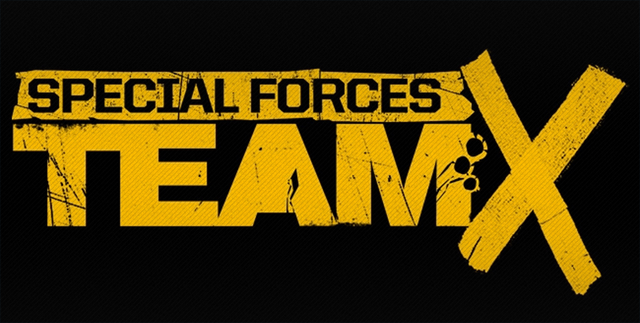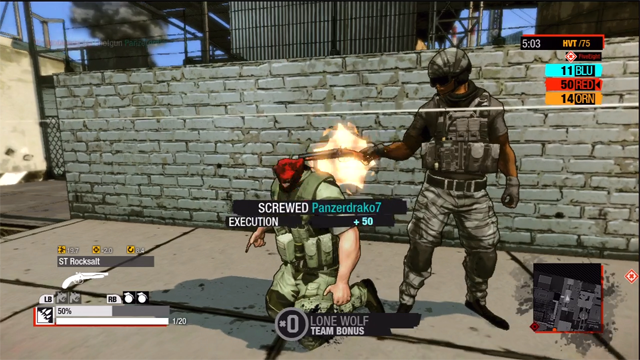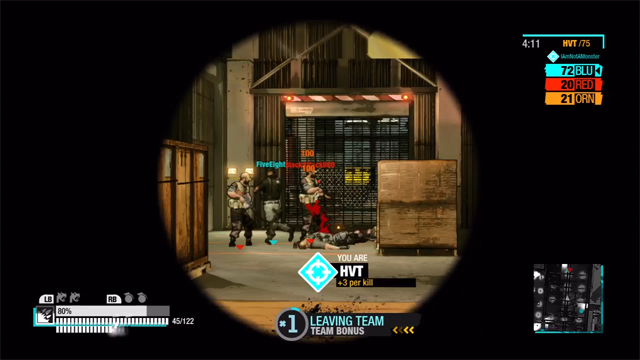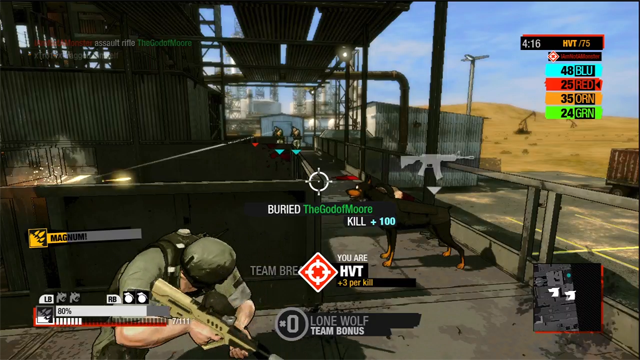Special Forces: Team X review (XBLA)
Special Forces: Team X was developed by Zombie Studios and published by Atari, Inc. It was released February 6, 2013 for 1200 MSP. A copy was provided for review purposes.
It’s been nearly three years since Zombie Studios’ last crack at an XBLA shooter, Blacklight: Tango Down, and in that time, they’ve cultivated a hard-core PC following with its free-to-play successor Blacklight: Retribution. Now heralding the return of Zombie’s shooter-centric capability to Xbox Live Arcade, Special Forces: Team X delivers a mostly satisfying multiplayer fix with enough style to overlook the one-note experience. STX isn’t targeted at the ultra-competitive; it’s designed around ease of use, accessibility, and plucking enough chords to resonate with everyone in some way, even if it never particularly excels at any one of them.
It’s impossible not to see the reflection of other titles in the glossy presentation of Special Forces: Team X. The lean character bodies and cel-shaded visuals immediately drum up thoughts of Borderlands, while the handling, cover-system and gun mechanics are unabashedly lifted from the Gears of War series. This isn’t a slight on the title, to the contrary, there’s an admirable confidence in the way Zombie Studios has surveyed the landscape, imitating proven success, rather than trying to reinvent the wheel. The amalgamation of gaming’s giants makes for a beautiful creature both accessible and familiar, but there’s something missing behind the eyes, and it’s little more than the sum of its parts.
Here’s what we liked:
Stylish, yet unrefined – Special Forces: Team X carries itself with particular style. It’s not just the aggressive, clean, non-threatening aesthetic. It’s the ultra-militaristic accouterments paired with chainsaws, the ragdoll physics and strike-a-pose taunts that toe the line between serious and satire. Like an uncomfortable joke delivered in deadpan, it’s tough to know when to giggle, and when to look away. With both barrels of a one-handed scattergun nudged against the skull of a subdued victim, the slapstick motif clashes with grim wartime realities in the ensuing fountain of cartoon crimson spurting wildly from the remnants of a brain stem. Somehow, this juxtaposition works in Special Forces’ favor. The no-nonsense shooter with a splash of silly, or maybe vice versa, it’s hard to tell. But it’s provocative.
There’s no “I” in team – Solving one of the more challenging aspects of competitive team multiplayer, Special Forces: Team X emphasizes the cohesive combat unit with elegant design. Perching near a teammate for a few moments initiates the team-bonus score multiplier, which continues to build while you’re within range. Suddenly every action becomes a dense, rippling vein of points just waiting to be tapped. Handfuls of mute players now blossom into wordless squads: each huddled behind some scrap of cover, each covering a potential point of attack. The allure of individual reward becomes, ironically, the best team facilitator. Unfortunately, the technical limitations of the feature can’t always support its spirit. Most areas are simply too large to defend with the close proximity required to sustain a bonus; forcing you to either abandon your multiplier in favor of a secure perimeter, or stick it out with your squad, hoping a grenade doesn’t land in the sweet spot and kill everyone.
The Cartographer – Mixing up traditional arena selection, Zombie’s newfangled Dynamic Map Tile System embraces the casual-core spirit of Special Forces: Team X. Each round players vote which three slices of canned terrain are fused at the seams, building an ever-changing environment from familiar slabs of turf. While some tiles are resoundingly more popular than others, with three chances to select a favorite your odds of coming away with a little piece of satisfaction are favorable. It’s more novelty than a fundamental fix for stale environments, as emphasis eventually shifts toward the ways each piece fits together, rather than the tiles themselves. But it’s an inviting system allowing players to grab a morsel of victory before the round ever starts.
Pick your poison – Browsing the lobby for joinable hosts or hitting Quick Match and spinning the wheel of mystery lands you in an impressive variety of objectives. Teams of six-on-six make up most of the frays in tried-and-true Deathmatch, Capture the Flag, King of the Hill and Domination game modes, though nearly all modes support multi-team variants. High Value Target is a particularly nice addition: transforming the first player to score a frag into the HVT, securing score bonuses for their team and themselves. There’s plenty of ways to grind out experience in STX, with objective modes taking the spotlight thanks to the pace and nature of engagements.
Here’s what we didn’t like:
This is my rifle, there are many like it – Earned experience unlocks true-to-life weaponry, attachments, equipment, passive and active skills (perks), and a whole host of cosmetic wrappings to dress your toy soldier. You’ll have ample time to become acquainted with each new weapon and ancillary en route to level forty, though none of them feel particularly different from the other weapons in their class. Assault rifles all handle similarly with noticeable but minor differences between each new piece of hardware, and by the time you’ve reached the “best” guns on the list, you’ll be just as effective with the AK-starter-kit as the next-to-last FAMAS. Compounding the issue, you’ll rarely need to custom your arsenal further than slapping the most recent attachments onto a newly acquired weapon, as unlocked items work universally across all applicable firearms.
You got serv(er)ed – Special Forces: Team X suffers from the host/player shortcomings associated with most competitive online console affairs. The host’s latency advantage is mitigated somewhat by the fact most engagements are conducted from behind cover, slinging walls of hot lead at an opponent for accuracy-by-volume effectiveness. Still, when every shot trained through the pinhole capabilities of a rifle scope whistle harmlessly through the target, the issue’s glaringly apparent. While it’s rare to see a host back out of a game – possibly thanks to the casual nature of STX – it’s still a factor worth mentioning; as is the one-in-fifty occurrence of getting stuck on a transitional loading screen, forcing an exit through the dashboard.
The little things – While there’s no singular issue tarnishing the experience, small annoyances bubble through STX’s ostensibly polished surface. The lack of item information, for example, is certainly frustrating. What’s the difference between the Recon Silencer and the Elite Silencer? How does the Assault Dog differ from the Attack Dog? Similarly, you’re not directed to newly unlocked items once they’ve become unlocked, meaning you’ll be skimming through a dozen categories of gear with each new level. Moreover, the match results displayed at round’s end appear for mere seconds before you’re off to the next screen, regularly disappointing when you miss that soul-affirming statistical pat on the back after a job well done. Sure, these are superficial oversights, but they’re a few of many that band together for more eye-rolling moments than necessary.
Special Forces: Team X covers quite a few bases, offering up team-centric combat that’s both stylishly fun, and irreverent. It’s easy to see where the mark lies: an accessible shooter that doesn’t require pinpoint accuracy or master-strategy. It elicits giggles as ragdoll corpses dangle from the warehouse rafters, placed there by the obscene combustive prowess of an RPG or airstrike power weapon. Most importantly it’s easy to pick up and play, and when you incite all-out taunt-warfare – as your tough-as-nails soldier rides his weapon like a stick horse while smacking his posterior – it’s easy to have a great time.
However, in that effort to appeal to an undefined casual audience, much of the experience never reaches its lofty potential. As online-only titles live and die by their community – which is still thriving in this case – the price point could be Special Forces‘ greatest hurdle as players inevitably dwindle. It’s a wonder why Zombie Studios didn’t return to the free-to-play structure, substituting level progression for an in-game earned currency system, allowing users to purchase weapons and more outlandish gear if they so desired. There’s a lot to initially like about Special Forces: Team X, but just as it hits its stride, it also peaks, and never evolves into more. We highly recommend you download the Special Forces: Team X demo, knowing that, for better or worse, what you see is what you get.
Score: Try It!






